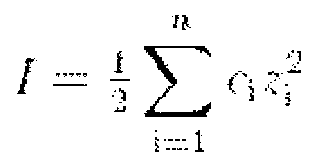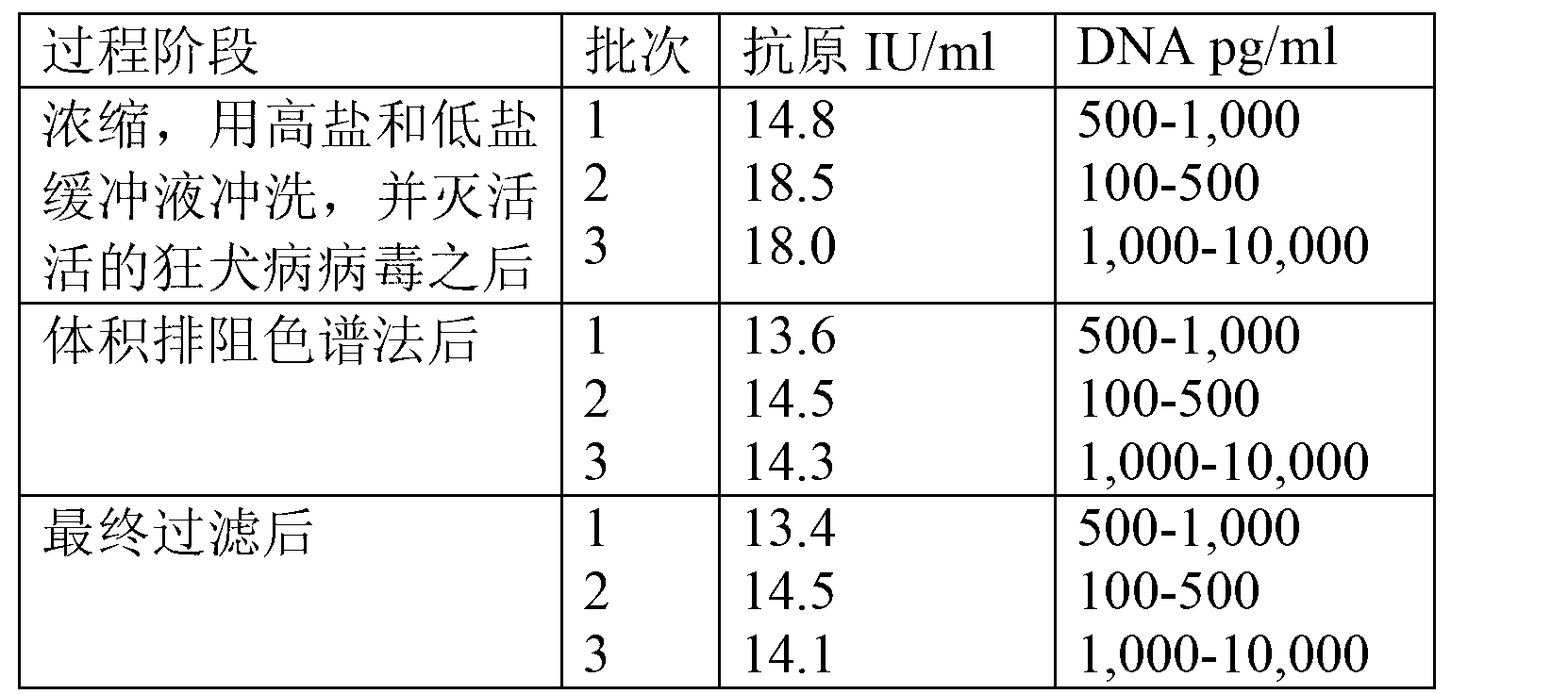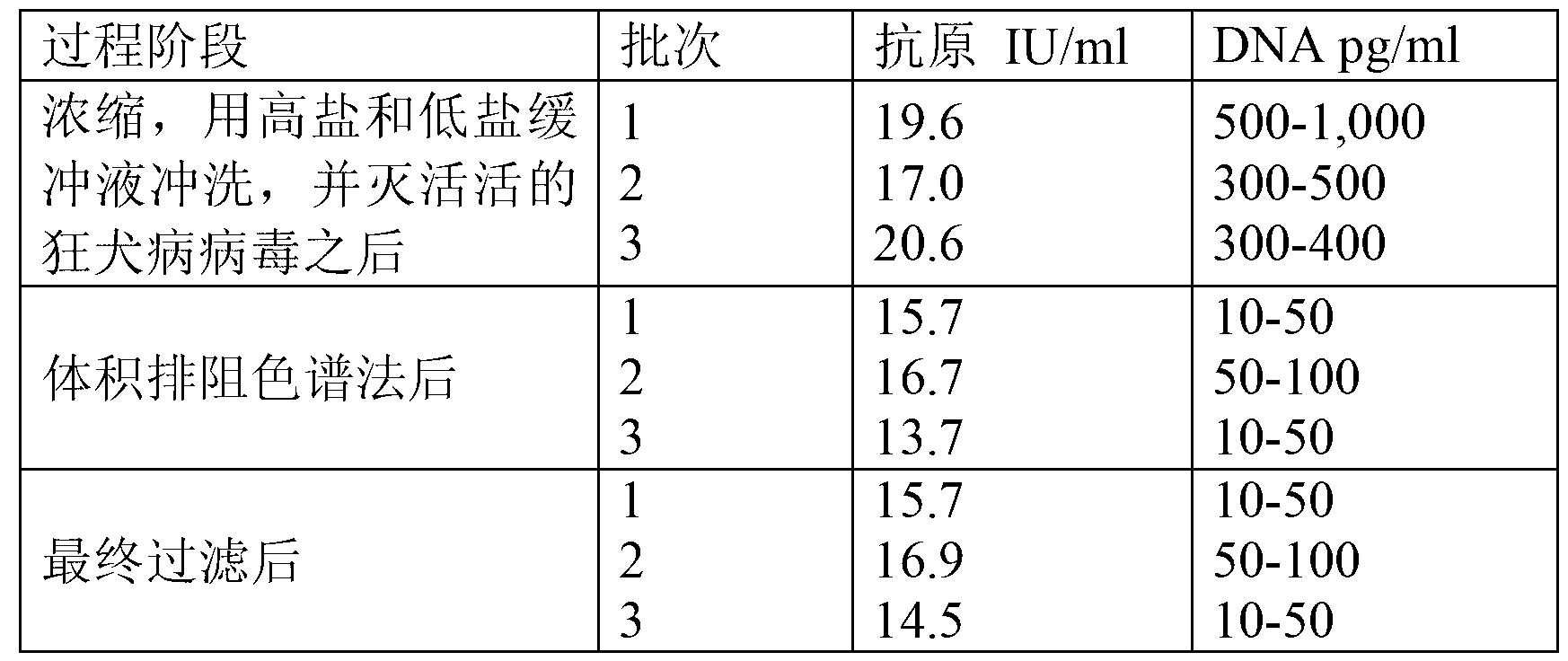Method for reducing DNA impurities in viral compositions
一种组合物、病毒的技术,应用在病毒纯化,狂犬病病毒的生产,Vero细胞领域,能够解决天然摄入率不高等问题,达到克服局限性的效果
- Summary
- Abstract
- Description
- Claims
- Application Information
AI Technical Summary
Problems solved by technology
Method used
Image
Examples
Embodiment 1
[0116] Example 1 - Old procedure without using high ionic concentration buffers
[0117] This example illustrates how the residual DNA content of a rabies virus solution is not reduced when the purification process does not use buffers of high ionic concentration to wash the virus composition.
[0118] CTN rabies virus was grown in Vero cells and live rabies virus was harvested from the supernatant, ie without the use of nucleases. Viral supernatants were first purified to remove residual DNA from the suspension, then live rabies virus particles were concentrated to up to 50-fold the original concentration by ultrafiltration with low salt concentration prior to chemical inactivation with β-propiolactone buffer rinse. At this point, the antigen content and residual DNA were measured using the standard test method specified in the Chinese Pharmacopoeia 2010 (see Table 1 below).
[0119] Afterwards, the virus solution was subjected to size exclusion chromatography using 4FF aga...
Embodiment 2
[0125] Example 2 - Effect of Ion Concentration on DNA Clearance at Laboratory Scale
[0126] This example illustrates the effect of different ion concentrations on reducing the residual DNA content of a rabies virus solution on a laboratory scale.
[0127] CTN rabies virus was grown in Vero cells and live rabies virus was harvested from the supernatant, ie without the use of nucleases. Viral supernatants were filtered, then concentrated by ultrafiltration to up to 50-fold the original concentration, rinsed in high ionic buffer and then in low salt buffer prior to chemical inactivation with β-propiolactone Rinse in. At this point, the antigen content and residual DNA were measured using the standard test method specified in the Chinese Pharmacopoeia 2010 (see Table 2 below).
[0128] Afterwards, wash the virus solution with high ionic concentration buffer (containing 0.5M (B), 1M (C), 2.0M (D), 3.0M (E) NaCl) and regular PBS buffer (A). After rinsing the virus solution, size...
Embodiment 3
[0134] Example 3 - Novel process for large scale use of high ionic concentration buffers
[0135] This example illustrates how reducing the residual DNA content of a rabies virus solution preserves the immunogenicity of rabies virus particles.
[0136] CTN rabies virus was grown in Vero cells and live rabies virus was harvested from the supernatant, ie without the use of nucleases. Viral supernatants were filtered, then concentrated by ultrafiltration to up to 50-fold the original concentration, rinsed in high ionic buffer and then in low salt buffer prior to chemical inactivation with β-propiolactone Rinse in. At this time, the antigen content and residual DNA were measured with the standard test method specified in the Chinese Pharmacopoeia 2010 (see Table 3 below).
[0137] Then, wash the virus solution with a high ion concentration buffer containing 1M NaCl. After washing, size exclusion chromatography was performed using 4FF agarose medium. At this point, the antigen ...
PUM
 Login to View More
Login to View More Abstract
Description
Claims
Application Information
 Login to View More
Login to View More - R&D
- Intellectual Property
- Life Sciences
- Materials
- Tech Scout
- Unparalleled Data Quality
- Higher Quality Content
- 60% Fewer Hallucinations
Browse by: Latest US Patents, China's latest patents, Technical Efficacy Thesaurus, Application Domain, Technology Topic, Popular Technical Reports.
© 2025 PatSnap. All rights reserved.Legal|Privacy policy|Modern Slavery Act Transparency Statement|Sitemap|About US| Contact US: help@patsnap.com



